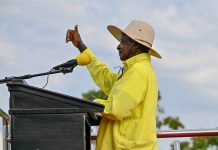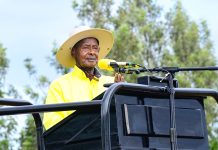By David Mwanje
Uganda’s economy defied the odds, clocking a robust 6.3% real GDP growth for the financial year ended June 30, 2025, according to the Bank of Uganda’s (BoU) freshly unveiled Integrated Annual Report. This marks a steady climb from 6.1% in the prior year, fueled by a bumper agricultural harvest, industrial resurgence, and unyielding services momentum.
But as Governor Michael Atingi-Ego emphasized in the report, this isn’t just numbers on a page it’s a testament to “prudent monetary policy, effective monetary-fiscal coordination, and a relatively stable exchange rate” that kept inflation tame at 3.5%.
The report paints a vivid picture of an economy punching above its weight. Agriculture, the backbone of Uganda’s GDP, expanded 6.6% up from 5.6% thanks to government-backed initiatives like the Agricultural Credit Facility (ACF), administered by BoU. “We’ve empowered farmers and agribusinesses with affordable financing for mechanization and post-harvest handling,” Atingi-Ego noted, crediting ACF disbursements of UGX 253 billion to 3,224 projects.
Industry wasn’t far behind, growing 7.0% versus 5.5% last year, with light manufacturing and agro-processing leading the charge. The Small Business Recovery Fund (SBRF), another BoU-administered lifeline, injected UGX 59 billion into 2,994 SMEs, many reeling from COVID aftershocks.
“These aren’t handouts; they’re catalysts for post-pandemic rebound,” the Governor asserted in a recent X post (October 4, 2025), highlighting how SBRF’s block allocation model lending up to UGX 20 million without collateral fostered inclusivity, with 64% of beneficiaries being women and youth.
Yet, this growth story isn’t without its plot twists. Headline inflation ticked up to 3.5% from 3.2%, driven by core components like services (5.6%) amid rising domestic demand. The Uganda shilling’s 2.7% appreciation against the USD mid-rate at UGX 3,678 acted as a balm cushioning imported inflation.
Gross official reserves swelled to USD 4.3 billion, affording 3.9 months of import cover — a buffer against shocks. “We’ve fortified external buffers with a Strategic Asset Allocation framework, even dipping into gold diversification,” Atingi-Ego told CNBC Africa on September 28, 2025, underscoring preparations for oil windfalls.
Fiscal-monetary harmony was the unsung hero. With government borrowing ramping up to UGX 12.1 trillion domestically, yields on T-bills climbed to 14.8% for 364-day papers, yet investor appetite held firm. Private sector credit edged up 8.8%, though unevenly agriculture soared 13.1% while manufacturing lagged at 4.6%.
Looking ahead, BoU projects 6.0–6.5% growth for FY 2025/26, accelerating to 8% over five years, buoyed by oil investments and the tenfold growth strategy. But risks loom: commodity volatility, weather whims, and global tightening.
Atingi-Ego’s closing remark summed it up: “As we near our 60th anniversary, we’re steadfast price stability and sound finance for socio-economic transformation.” With GDP humming and reserves fortified, Uganda’s business engine is revving but policymakers must keep the pedal steady.























